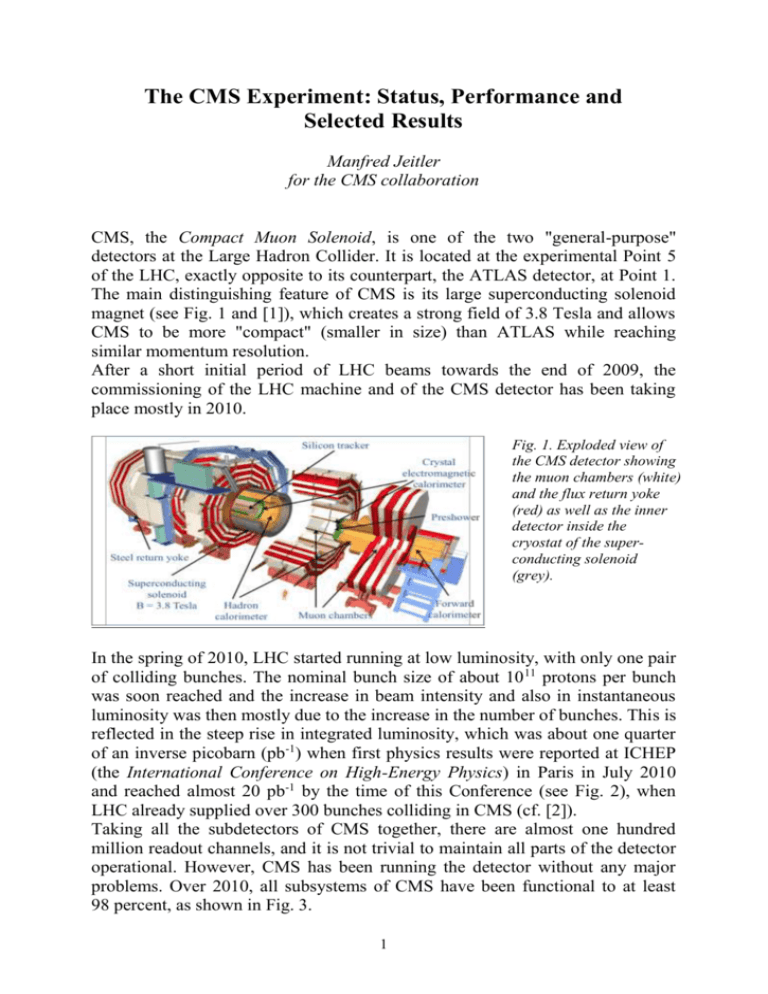Jeitler
advertisement

The CMS Experiment: Status, Performance and Selected Results Manfred Jeitler for the CMS collaboration CMS, the Compact Muon Solenoid, is one of the two "general-purpose" detectors at the Large Hadron Collider. It is located at the experimental Point 5 of the LHC, exactly opposite to its counterpart, the ATLAS detector, at Point 1. The main distinguishing feature of CMS is its large superconducting solenoid magnet (see Fig. 1 and [1]), which creates a strong field of 3.8 Tesla and allows CMS to be more "compact" (smaller in size) than ATLAS while reaching similar momentum resolution. After a short initial period of LHC beams towards the end of 2009, the commissioning of the LHC machine and of the CMS detector has been taking place mostly in 2010. Fig. 1. Exploded view of the CMS detector showing the muon chambers (white) and the flux return yoke (red) as well as the inner detector inside the cryostat of the superconducting solenoid (grey). In the spring of 2010, LHC started running at low luminosity, with only one pair of colliding bunches. The nominal bunch size of about 10 11 protons per bunch was soon reached and the increase in beam intensity and also in instantaneous luminosity was then mostly due to the increase in the number of bunches. This is reflected in the steep rise in integrated luminosity, which was about one quarter of an inverse picobarn (pb-1) when first physics results were reported at ICHEP (the International Conference on High-Energy Physics) in Paris in July 2010 and reached almost 20 pb-1 by the time of this Conference (see Fig. 2), when LHC already supplied over 300 bunches colliding in CMS (cf. [2]). Taking all the subdetectors of CMS together, there are almost one hundred million readout channels, and it is not trivial to maintain all parts of the detector operational. However, CMS has been running the detector without any major problems. Over 2010, all subsystems of CMS have been functional to at least 98 percent, as shown in Fig. 3. 1 Fig. 2. a (left): Integrated luminosity delivered to CMS by LHC (red) and recorded by CMS (blue) between March and October, 2010. The flat section in September reflects the period of several weeks of LHC machine development during which the injection of bunch trains was commissioned. b (right): integrated luminosity per LHC fill in inverse nanobarns (nb-1) during the weeks preceding this Conference (September 20 to October 10, 2010). Fig. 3. Percentage of availability of the various subdetectors of CMS during the 2010 run. Ultimately the LHC will house about 2800 bunches in an orbit, which will be spaced by 25 ns. During the commissioning in 2010 the maximum number of bunches was only a few hundred, which allowed to keep much wider distances between bunches (Fig. 4). While being due to requirements of the accelerator, this has also been beneficial for the experiments during their commissioning stage: it allowed for easier synchronization between subdetectors and permitted to suppress detector noise or afterpulses by requiring a coincidence with the passing proton bunch as measured by beam pickup detectors. 2 Fig. 4. Typical LHC bunch structure over one orbit (left), and showing a zoom over the first 200 possible bunch positions (right). During this run, the LHC delivered bunch trains of 8 bunches. While exactly the same bunches collide in ATLAS and CMS, some bunches colliding in ALICE or LHCb may not collide in CMS. Therefore, the second group in the right frame shows only 7 colliding bunches. To match the steady increase in LHC luminosity, the triggering system of CMS had to be adapted. While at the beginning of operation in 2010 it was possible to trigger on any passing pair of colliding bunches (detected by beam pickup detectors: "zero-bias trigger") or on any activity in the detector (detected by beam scintillation detectors (BSC): "minimum-bias trigger"), over time triggering had to become more and more selective, by triggering mostly on "physics objects" (such as muons, electrons, jets etc.) and their coincidences. CMS uses a two-stage trigger. The Level 1 is implemented in electronics and reduces the data rate to a maximum of 100 kHz (see [3]). Trigger signals from the electromagnetic and hadron calorimeters are collected by the Global Calorimeter Trigger, those from the various muon detectors are collected in the Global Muon Trigger. Trigger requests from these two systems and from a few additional sources are fed into the Level-1 Global Trigger (Fig. 5), which takes the Level-1 decision based on pre-defined criteria programmed in firmware and distributes the readout request ("Level-1 Accept") to all subdetectors. Fig. 5. The Level-1 Global Trigger crate of CMS. The rightmost module is the Global Muon Trigger and receives signals from the various muon subdetectors via the thick black cables. Signals from the Global Calorimeter Trigger are received via the blue-green cables in the middle. The black cables to the left distribute the trigger decision to all subsystems. 3 In case of a Level-1 Accept all parts of the CMS detector are read out in full resolution (also subdetectors that do not participate in the Level-1 decision, such as the silicon tracker) and the full data are made available to the computer farm of the High-Level Trigger (HLT; differently from ATLAS, CMS does not have a hardware Level-2 trigger based on "regions of interest"), which carries out the complete reconstruction of all events and selects those which are sent to the CERN computing center on the Meyrin site for permanent storage at the Computing Grid's "Tier-0". The HLT output stream size was originally planned to be 100 Hz but due to the good performance of the computing system CMS has in fact been taking data at a stable output rate of several times this rate (see Fig. 6). Fig. 6. CMS data flow monitoring panel showing the Level-1 trigger rate, event size, subdetector states, data logging rate and accumulated data size for the current run. As the Level-1 trigger uses data of reduced resolution, the parameters on which its decision is based (such as "transverse energy") will not match exactly the values obtained during final reconstruction, and in order to reach clean and efficient data samples the offline analysis thresholds must be chosen somewhat higher than the online trigger thresholds. Fig. 7 shows the "turn-on curves" of Level-1 trigger efficiency against the transverse energy reconstructed off line for various calorimeter trigger objects. Ideally, triggers should be clean (trigger only if the trigger condition is really fulfilled) and efficient (always trigger if the conditions is fulfilled). This means that the turn-on curves should be steep and 4 have no big tails at the bottom (cleanliness) or top (efficiency), which is the case for CMS. Fig. 7. Turn-on curves of the Level-1 trigger efficiency plotted against the reconstructed transverse energy for the electron/gamma trigger with 8 GeV nominal threshold (left) and for jet triggers with several different thresholds (right). Obviously, taking the physics data is only part of the experiment's job and it is no less important to make sure that these data are of good quality. After many years of detailed Monte-Carlo studies it is important to see that the CMS detector is really understood and that resolutions and other features as obtained from the analysis of accelerator data match the values derived from simulations (see Fig. 8). Fig. 8. The primary vertex resolution obtained by the CMS detector versus the number of reconstructed tracks along the LHC beam direction (i.e. in Z, left) and perpendicular to it in the horizontal plane (in X, right) for several different ranges in transverse momentum. Data (full symbols) and Monte Carlo simulation (open symbols) show good agreement. 5 The known members of the "particle zoo" up to the W and Z boson mass have been clearly identified in the data (Fig. 9) and work is ongoing to obtain a clear top-quark signal [4]. So, the CMS detector has been calibrated against known physics channels and is delivering first results on new effects never seen before (cf. [5] and the other CMS papers presented at this Conference). Fig. 9. Invariant-mass spectrum of μ+μ- events seen in the CMS detector. Acknowledgements I would like to thank all colleagues in the CMS collaboration for their huge collective effort in constructing and running the experiment and analyzing the data, and the LHC accelerator team for achieving the impressive performance we have seen on the side of the machine. I would also like to thank the Organizers for making this Conference such an interesting, stimulating and pleasant experience. REFERENCES [1] CMS Collaboration, The CMS experiment at the CERN LHC, JINST 3: S08004, 2008. [2] W. Venturini-Delsolaro, Status of the LHC Machine, paper presented at this Conference. [3] CMS TriDAS Project, Volume 1: Trigger Technical Design Report. CERN/LHCC 2000 - 38, CMS TDR 6.1. December 15, 2000. [4] L. Scodellaro, Top quark physics at CMS, paper presented at this Conference. [5] The CMS collaboration, Observation of long-range, near-side angular correlations in proton-proton collisions at the LHC. JHEP 2010, no. 9, 1-38. 6





